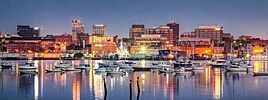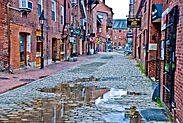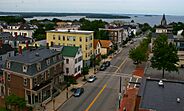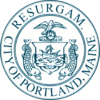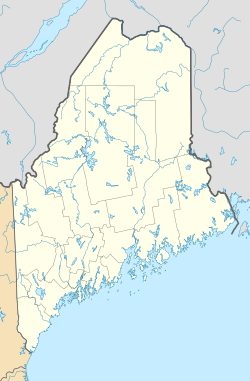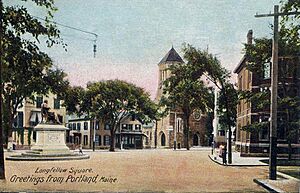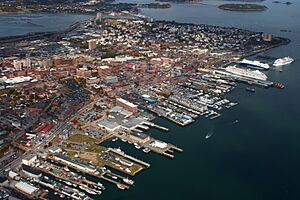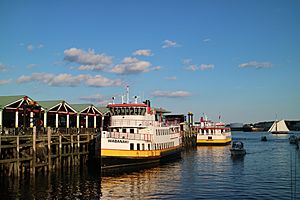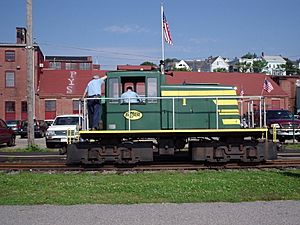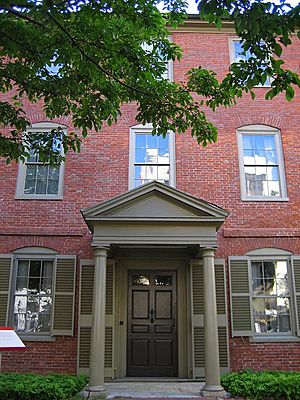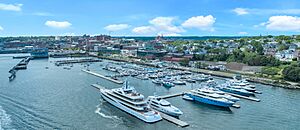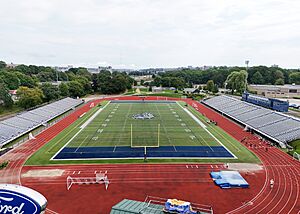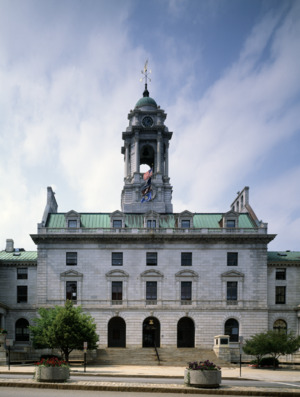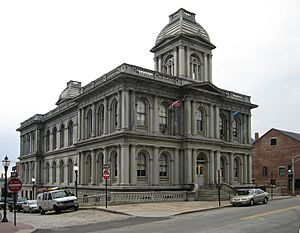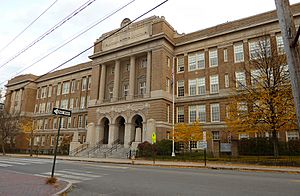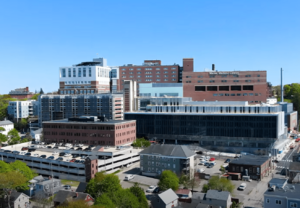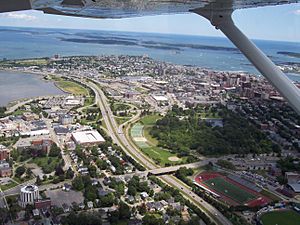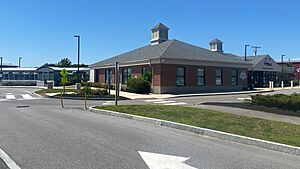Portland, Maine facts for kids
Quick facts for kids
Portland
|
|||||
|---|---|---|---|---|---|
|
|
|||||
|
|||||
| Nickname(s):
The Forest City
|
|||||
| Motto(s): | |||||
| Country | United States | ||||
| Region | New England | ||||
| State | Maine | ||||
| County | Cumberland | ||||
| Settled | 1632 | ||||
| Incorporated | July 4, 1786 | ||||
| Named for | Isle of Portland | ||||
| Government | |||||
| • Type | Council–manager | ||||
| Area | |||||
| • City | 69.44 sq mi (179.85 km2) | ||||
| • Land | 21.54 sq mi (55.79 km2) | ||||
| • Water | 47.90 sq mi (124.06 km2) | ||||
| • Urban | 135.91 sq mi (352.0 km2) | ||||
| Elevation | 62 ft (19 m) | ||||
| Population
(2020)
|
|||||
| • City | 68,408 | ||||
| • Rank | US: 519th | ||||
| • Density | 3,175.86/sq mi (1,226.21/km2) | ||||
| • Urban | 205,356 (US: 188th) | ||||
| • Urban density | 1,657.7/sq mi (640.0/km2) | ||||
| • Metro | 556,893 (US: 103rd) | ||||
| Demonym(s) | Portlander | ||||
| Time zone | UTC−5 (EST) | ||||
| • Summer (DST) | UTC−4 (EDT) | ||||
| ZIP Codes |
04101–04104, 04108–04109, 04112, 04116, 04122–04124
|
||||
| Area code(s) | 207 | ||||
| FIPS code | 23-60545 | ||||
| GNIS feature ID | 573692 | ||||
Portland is the largest city in the state of Maine, USA. It is also the main city of Cumberland County. In 2020, Portland had a population of 68,408 people. The larger area around Portland, called Greater Portland, has about 550,000 people. This makes it Maine's biggest metropolitan area.
Long ago, Portland was important for shipping and factories. Today, its economy mainly focuses on services. The Port of Portland is the second busiest seaport in the New England area.
The city's seal shows a phoenix bird rising from ashes. This symbolizes how Portland rebuilt itself after four big fires. The city was named after the Isle of Portland in England. Later, Portland, Oregon, was named after Portland, Maine. The name Portland comes from an old English word meaning "land around a harbor."
In 2022 and 2023, U.S. News & World Report said Portland was one of the "best places to live" in the United States.
History of Portland
The first people to live on the Portland peninsula were the Algonquin-speaking Eastern Abenaki tribe. They called the area Machigonne, meaning "great neck."
The first European settler was Christopher Levett, an English sea captain. He received land in 1623 to start a settlement in Casco Bay. He built a stone house and left ten men there, but the settlement did not last.
The peninsula became a fishing and trading village in 1632, named Casco. In 1658, the Massachusetts Bay Colony took over, and the town's name changed to Falmouth. In 1676, the Abenaki tribe destroyed the village during King Philip's War. It was rebuilt, but then largely destroyed again in 1690 during King William's War.
During the American Revolutionary War, the Royal Navy burned Falmouth on October 18, 1775. After the war, a part of Falmouth called The Neck grew quickly as a shipping center. In 1786, this area became its own town and was named Portland.
Portland's economy faced challenges during the Embargo Act of 1807 and the War of 1812.
In 1820, Maine became a state, and Portland was its first capital. In 1832, the capital moved to Augusta.
In 1853, the Grand Trunk Railway connected Portland to Montreal. This made Portland an important winter seaport for Canadian goods. The Portland Company built many steam locomotives and other railway equipment. It was once the city's biggest employer. After 1923, Canadian trade moved to Halifax, causing Portland's economy to slow down.

On June 26, 1863, during the American Civil War, Confederate soldiers entered Portland Harbor. This led to the Battle of Portland Harbor, one of the northernmost battles of the war. On July 4, 1866, a huge fire, known as the 1866 Great Fire of Portland, Maine, destroyed most of the city's buildings. More than 10,000 people lost their homes.
In 1899, Portland grew by adding the nearby city of Deering. This opened up new areas for development.
In 1967, a controversial project began to build a new road, Franklin Street. This project removed many homes and businesses. Later, the opening of The Maine Mall in South Portland in 1971 affected downtown Portland's economy. However, tourists and new businesses helped to bring life back to the Old Port.
Since the 1990s, the Bayside area has developed quickly. It now has popular grocery stores and a charter school. Other areas like India Street and Munjoy Hill have also seen new buildings. The Maine College of Art has helped to improve the downtown area. Universities like the University of Southern Maine and the University of New England are also expanding their campuses in Portland.
Portland is known as a great city for walking. You can take many tours to see its history and architecture.
Geography and Climate
According to the United States Census Bureau, Portland covers about 69.44 square miles (179.85 km2). About 21.31 square miles (55.79 km2) is land, and 48.13 square miles (124.06 km2) is water. Portland is located on a peninsula in Casco Bay, which is part of the Gulf of Maine and the Atlantic Ocean.
Portland shares borders with South Portland, Westbrook, and Falmouth.
Portland's Climate
Portland has a humid continental climate. This means it has cold, snowy winters that often last a long time. Summers are warm to hot but shorter. The average high temperature is about 30°F (0°C) in January and 80°F (27°C) in July. Temperatures reach 90°F (32°C) about four days a year. Winter lows of 0°F (-18°C) or below happen about 10 nights a year.
The area can experience strong winter storms called nor'easters. These storms bring high winds and often more than a foot of snow. Portland gets about 47.2 inches (120 cm) of rain each year, spread throughout the year. It also gets about 69 inches (175 cm) of snow annually. However, the amount of snow can change a lot each winter.
Hurricanes or tropical storms rarely hit Portland directly. This is partly because the Atlantic waters off Maine are usually cooler. Extreme temperatures have ranged from -39°F (-39°C) in 1943 to 103°F (39°C) in 1911 and 1975.
Sea-Level Changes
Portland's coast is one of the fastest-warming saltwater areas. Sea levels are expected to rise by about 10–17 inches (25–43 cm) by 2030, compared to levels in 2000. This is a big concern for people living near the ocean and for marine life.
In 2022, a report from the National Oceanic and Atmospheric Administration said that sea level in Portland could rise by six inches (15 cm) by 2050. It could rise by two feet (61 cm) by 2060 and two to six feet (61–183 cm) by 2100.
In January 2024, Portland had a record-high tide of 14.57 feet (4.44 m). This, along with heavy rain and strong winds, caused serious flooding.
Neighborhoods and Housing
Portland has many neighborhoods that residents recognize. These neighborhoods do not have their own legal power, but they often have local groups that work with the city government.
On March 8, 1899, Portland added the nearby city of Deering. This made Portland much larger and opened up new areas for building. Deering High School used to be the public high school for Deering.
Some of Portland's neighborhoods include the Arts District, Bayside, Deering Center, Downtown, East Deering, East End, Munjoy Hill, the Old Port, Parkside, Peaks Island, and the West End.
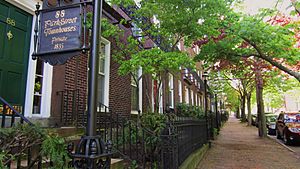
Since the early 2000s, many Portland neighborhoods have seen changes that have made housing more expensive. This has caused some long-time residents to find it harder to afford to live in their neighborhoods. In 2015, landlords in the city raised rents by an average of 17.4%. This was the second-biggest rent increase in the country that year.
Housing Efforts
In November 2020, Portland voters approved a plan called the "Green New Deal." This plan included rules for new housing developments. It said that developments with 10 or more units must include 25% affordable housing. Voters also approved a rent control rule that limited how much rents could increase each year. In 2022, voters made these rules even stronger.
Portland has also responded to Maine's 2022 statewide housing law, LD 2003. This law requires cities to allow more housing units in certain areas. In December 2023, the city council voted to allow up to four housing units on residential lots. They also removed parking requirements for these types of homes.
The city aims to build 256 new housing units each year from 2017 to 2027. It is currently on track to meet this goal. Since 2010, the city has approved about 6,400 new housing units.
Economy and Culture
Portland is Maine's economic center. It has the state's largest port and population, and it is close to Boston. Over the years, Portland's economy has changed. It used to focus on fishing, factories, and farming. Now, it mainly focuses on services. Many banks and financial companies have their main Maine offices in Portland. Several companies, like Unum and Covetrus, have their headquarters here.
The city's port is also becoming more active. In 2016, the first-ever container train left the new International Marine Terminal. It carried bottled tap water made locally.
In January 2020, Portland was chosen as the location for a new research institute. This institute focuses on artificial intelligence and machine learning.
Arts and Culture in Portland
Portland has a rich history in the arts. In the early 1800s, it was a major arts center. Famous writers like Henry Wadsworth Longfellow and John Neal started their careers here.
Since 2000, Portland has hosted a monthly "First Friday Art Walk." During this event, art galleries open their doors, attracting thousands of visitors.
Places to Visit
The Arts District, located on Congress Street, is a hub for culture. It includes the Portland Museum of Art, Portland Stage Company, Maine Historical Society & Museum, Portland Public Library, Maine College of Art, and the Children's Museum of Maine. You can also find many art galleries and studios here.
Portland has several historic parks, including Baxter Boulevard around Back Cove, Deering Oaks Park, the Eastern Promenade, and Western Promenade.
Thompson's Point has been redeveloped since the 2010s. It now has a concert venue, an ice rink, hotels, restaurants, and breweries.
Famous Buildings
The spire of the Cathedral of the Immaculate Conception has been a key part of Portland's skyline since 1854. The United States Custom House on Fore Street, built in 1868, is another important building.
Franklin Towers is a 16-story residential building. It was Maine's tallest residential building until 2023. The Time and Temperature Building on Congress Street is a well-known landmark. It has a large electronic sign on its roof that shows the time and temperature.
The Westin Portland Harborview, a large hotel, was completed in 1927. Photographer Todd Webb lived in Portland later in his life and took many pictures of the city.
Media in Portland
Portland has one daily newspaper, The Portland Press Herald/Maine Sunday Telegram. It was started in 1862. Other local publications include The Portland Forecaster, a weekly newspaper, and Portland Magazine.
Portland is the largest media market in Maine for both radio and television. Many radio stations broadcast from Portland, playing different types of music and news. Television stations like WCSH (NBC), WMTW (ABC), and WGME (CBS) serve the area.
City Traditions
Valentine's Day Phantom
In 1976, a group of unknown people started a tradition called the Valentine's Day Phantom. Every Valentine's Day, they would put hearts all over the city. In 1986, the U.S. Coast Guard almost caught a boat full of Phantoms near a ferry. The boat made it to Fort Gorges and put up a heart banner. The banner appeared on the fort again in 2017. In 2021, a heart flag appeared at the Central Fire Station.
In 2023, one leader of the effort, Kevin Farnham, passed away. His family shared his involvement and started a charity called Be A Kevin to keep the tradition going.
First Friday Art Walk
The First Friday Art Walk began in 2000. Art galleries in the Arts District would open their doors from 5 to 8 p.m. on the first Friday of each month. By 2012, this event became very popular.
Food and Drink Scene
Downtown Portland, including the Arts District and the Old Port, has many places to eat and drink. You can also find food trucks and carts on the streets, especially in the summer.
Some well-known restaurants include Fore Street, Duckfat, and Becky's Diner.
Food Recognition
Portland is known across the country for its great restaurants and food culture. Many food shows have visited the city, including $40 a Day and Anthony Bourdain: No Reservations. In 2018, Bon Appetit magazine named Portland the Restaurant City of the Year.
Beverages
Portland has many juice bars, coffee shops, tea houses, and breweries. Some famous breweries include D. L. Geary Brewing Company, Gritty McDuff's Brewing Company, and Shipyard Brewing Company.
The city is also known for its clean tap water, which comes from Sebago Lake. The Environmental Protection Agency says Sebago Lake is one of the few water sources in the country that does not need extra filtering.
Farmers Markets
The Portland Farmers' Market takes place on Wednesdays in Monument Square and on Saturdays in Deering Oaks Park from May to November. From December to April, it is held at The Maine Girls Academy.
Vegetarian Food
Portland has the most vegan and vegetarian restaurants in Maine. In 2020, there were more than 200 vegetarian-friendly restaurants. The Portland Press Herald has a vegan food column. In 2011, Portland Public Schools started offering a daily vegetarian cold lunch. In 2019, they changed to a daily hot vegan meal option.
Food Festivals
Portland hosts several food and drink festivals:
- Festival of Nations (July)
- Greek Festival (June)
- Harvest on the Harbor (October)
- Italian Street Festival & Bazaar (August)
- Maine Brewers Festival (multiple times a year)
- Maine VegFest (October)
- Maine Restaurant Week (March)
- Maine Seaweed Week (spring)
Food History
The Portland Farmers Market has been running since 1768.
Canned corn was first developed in Portland by the N. Winslow company. By 1852, their canned corn was very popular. The historic B&M Baked Beans canning plant operated on the waterfront until 2021.
In the early 1900s, a "Little Italy" neighborhood grew around India Street. Amato's Italian delicatessen on India Street is said to be where the "Maine Italian sandwich" was first made in 1902.
In 1979, The Great Lost Bear opened and became known for its large selection of craft beers. In 1988, Gritty McDuff's opened, becoming the first brewpub in Maine since a time when alcohol sales were banned.
In 1991, Becky's Diner opened on Commercial Street. It has attracted famous visitors like Taylor Swift and former president Bill Clinton. In 2007, the Green Elephant opened and received praise for its vegetarian menu.
In 2024, ZU Bakery won a James Beard award for Outstanding Bakery. Atsuko Fujimoto, owner of Norimoto Bakery, won the James Beard award for Outstanding Pastry Chef or Baker.
Sports in Portland

Portland is home to four minor league sports teams:
- The Portland Sea Dogs, a baseball team linked to the Boston Red Sox, play at Hadlock Field.
- The Maine Celtics, a basketball team linked to the Boston Celtics, play at the Portland Exposition Building.
- The Maine Mariners, an ice hockey team linked to the Boston Bruins, play at Cross Insurance Arena.
- A new soccer team, Portland Hearts of Pine, started playing in 2025 at Fitzpatrick Stadium.
Portland also has the Portland Rugby Football Club, which started in 1969. Other teams include the Portland Lumberjacks (bowling) and Portland Rising (women's ultimate frisbee). In 2024, Sports Business Journal named Portland the best minor league sports market in America.
Past Sports Teams
Portland used to have other minor league ice hockey teams: the Maine Mariners (1977–1992) and the Portland Pirates (1993–2016). Both teams won championships.
The GPS Portland Phoenix soccer teams played from 2009 to 2020. The Maine Mammoths, an indoor football team, played in 2018.
Sports Facilities
The Portland Sports Complex has several stadiums and arenas:
- Hadlock Field for baseball (seats 7,368)
- Fitzpatrick Stadium for football, soccer, and other outdoor sports (seats over 6,000)
- Portland Exposition Building for basketball, indoor track, and concerts (seats 3,000)
- Portland Ice Arena for hockey and figure skating (seats 400)
Cross Insurance Arena has 6,733 seats after renovations in 2014.
The Portland area has many golf courses, tennis courts, and playgrounds. There are also over 100 miles (160 km) of nature trails. Portland hosts the Maine Marathon every October.
Parks and Recreation
Portland has more than 700 acres (283 ha) of open spaces and public parks. The most famous ones are the Eastern Promenade, Western Promenade, and Deering Oaks. The city and nearby communities are connected by 70 miles (110 km) of trails, managed by Portland Trails.
The Portland Parks Conservancy, a non-profit group, helps raise money for the city's parks. In 2021, they started the Portland Youth Corp. This paid program allows young people aged 14 to 16 to work in Portland's parks.
Organic Land Care
The city requires that organic land care methods be used on both public and private property. In 2018, the Portland City Council banned the use of man-made pesticides.
Historic Parks
Some of Portland's historic parks include:
- Baxter Boulevard
- Deering Oaks
- Eastern Promenade
- Lincoln Park
- Western Promenade
Parks with Trails
Notable trails and parks with multiple trails include:
- Bayside Trail
- East End Trail
- Evergreen Cemetery
- Fore River Sanctuary
Parks with Water Features
Parks with splash pads, pools, and beaches include:
- East End Beach
- Kiwanis Pool
- Payson Park
City Government
Portland has a council-manager government. This means a city council makes decisions, and a city manager handles the daily operations. The city council has nine members. Five members are elected from different districts, and four are elected from the city as a whole. They serve three-year terms.
From 1923 to 2011, the city council chose one of its members to be the Mayor of Portland. This was mostly a ceremonial role. In 2010, voters decided to elect the mayor directly. On November 8, 2011, Michael F. Brennan became the first directly elected mayor in 88 years. The mayor serves a four-year term. The current mayor is Mark Dion, who was elected in November 2023.
The city manager is chosen by the city council. The manager runs the city government day-to-day, appoints department heads, and prepares the city's budget. The current city manager is Danielle West.
Besides the city council, there is also an elected school board for the Portland Public School system. This board has five district members, four at-large members, and one chairman. Three students from local high schools also serve on the board.
In November 2013, Portland voters approved a rule to allow adults to possess and use certain plants. This made Portland the first city in the Eastern United States to do so.
In the U.S. House of Representatives, Portland is part of Maine's 1st congressional district. It is currently represented by Democrat Chellie M. Pingree.
Education in Portland
Portland has a long history of public and private schools. The private Portland Academy was founded in 1794. Portland High School, a public school, opened in 1821. The oldest part of the current Portland High School building was built in 1862-1863. The Maine College of Art was established in 1882.
Several colleges and universities are expanding in Portland. The University of Southern Maine is adding a large dormitory and student center. The University of New England plans to move its medical school to its Portland campus. Northeastern University's Roux Institute is building a new campus. These expansions could bring the total number of college students in the city to 15,000 within two decades.
High Schools in Portland
- Baxter Academy for Technology and Science (charter school)
- Casco Bay High School (public school)
- Cheverus High School (private school)
- Deering High School (public school)
- Portland Arts & Technology High School (public vocational school)
- Portland High School (public school)
- Waynflete School (private school)
Colleges and Universities in Portland
- Institute for Doctoral Studies in the Visual Arts
- Maine College of Art
- Roux Institute
- University of Maine School of Law
- University of New England
- University of Southern Maine
City Infrastructure
Fire Department
The Portland Fire Department (PFD) provides fire protection and emergency medical services 24/7. It was started on March 29, 1768. The PFD has over 230 firefighters and operates from seven fire stations in the city. It also has stations on islands like Peaks Island and Great Diamond Island. The department also has an Airport Division Station at the Portland International Jetport and a Marine Division Station.
Police Department
The Portland Police Department is the largest city police department in Maine.
Hospitals
Maine Medical Center is the largest hospital in Maine and the state's only Level I trauma center. Mercy Hospital is the fourth largest hospital in Maine.
Wastewater Management
The city has projects to improve water quality, like the Bedford Street Sewer Separation. This project aims to reduce pollution in Back Cove during heavy rains. The East End Treatment Plant, built in 1979, helps manage wastewater.
Transportation in Portland
Roads
Portland can be reached by major highways like I-95 (the Maine Turnpike), I-295, and US 1. U.S. Route 302, a scenic highway, ends in Portland.
Buses and Trains
Amtrak's Downeaster train service offers five daily trains. They connect Portland's station to cities south, ending in Boston. Trains also go north to Freeport and Brunswick.
Concord Coach Lines bus service connects Portland to other communities in Maine and to Boston. Both the Downeaster and Concord Coach Lines leave from the Portland Transportation Center.
Local Bus Service
Local bus service is provided by Greater Portland Metro.
Airports
Commercial flights are available at the Portland International Jetport (PWM). Several airlines offer direct flights to cities like Atlanta, Chicago, New York, and Washington, D.C.
Water Transportation
The Port of Portland is a popular destination for cruise ships and passengers. The Ocean Gateway International Marine Passenger Terminal serves these ships.
Casco Bay Lines operates passenger ferries year-round to many islands in Casco Bay. They also offer an auto ferry service to Peaks Island.
From 2014 to 2015, the cruise ship ferry Nova Star made daily trips to Yarmouth, Nova Scotia. Since 2016, Bay Ferries has operated a high-speed ferry called The Cat on this route. The trip takes about five and a half hours.
Sister Cities
Portland has several sister cities around the world:
 Arkhangelsk, Russia
Arkhangelsk, Russia Cap-Haïtien, Haiti
Cap-Haïtien, Haiti Garissa Township, Kenya
Garissa Township, Kenya Mytilene, Greece
Mytilene, Greece Shinagawa (Tokyo), Japan
Shinagawa (Tokyo), Japan
See also
 In Spanish: Portland (Maine) para niños
In Spanish: Portland (Maine) para niños


